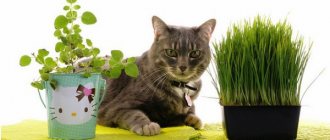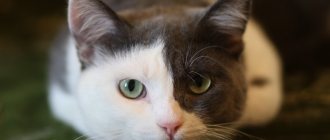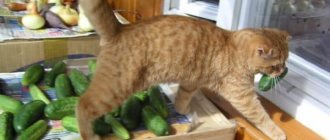What catnip looks like: photo and description. The plant has a purple flower and green leaves.
Although the main use of this plant is not related to the pet industry. It is a spice that is added to food and also to perfumes. Catnip also has healing properties: it is used for inflammatory diseases of the respiratory tract, anemia, migraines, poor appetite, depression, and is used against worms and infections. Some people manage to take it as a hallucinogen. And in ancient times, catnip was added to love potions, attributing magical properties to it. Although this opinion is based, rather, on the fact that the plant acts as a pheromone.
Catnip - description, photo
Catnip (lat. Népeta catária) is a perennial herbaceous plant reaching a height of up to 100 cm. This name, like others - catnip, lemon catnip, the grass received thanks to the indifference of representatives of the corresponding family to it.
Catnip. Click on the photo to enlarge.
Outwardly it looks like a straight long stem on which heart-shaped leaves with jagged edges are attached. The flowers are small, with purple or violet splashes. The aroma contains light notes of lemon. This description is conditional, since there are varieties.
If a person can confuse catnip with other greens, for example, lemon balm, then a cat will never be mistaken.
Description of the plant
Lemon catnip in the wild.
Lemon catnip grows actively in a number of regions:
- Central, Eastern and Western parts of Europe;
- Eastern part of Asia;
- western part of Siberia;
- Caucasus.
In appearance it is similar to the most common peppermint. The chemical composition of these plants is slightly different. Peppermint is rich in menthol. Catnip contains the substance nepetalactone in its stems and leaves. It is thanks to nepetalactone that the aroma of catnip contains subtle lemon tones.
Catnip leaves are light green and heart-shaped. Sometimes they may have white and pink spots on them. During flowering, small tassel-shaped flowers appear, located on long stems.
They spread low on the ground and twist together, quickly turning into dense bushes. In total there are more than 200 species of this plant. Cats and cats love to spend their time in these thickets. Catnip lures these animals with its aroma, similar to the smell that valerian emits. Many furry pets behave very strangely when meeting this plant, and sometimes even inappropriately.
Why cats love her
The secret why cats love catnip so much and its aroma, while they remain indifferent to others with a similar smell, has long been revealed. Our pets are attracted not by the aromatic smell itself, but by its source - nepetalactone.
This substance affects the neurons of the cat's brain, causing short-term hallucinations and changing the animal's behavior pattern.
It is difficult to predict exactly how a pet will behave under its influence. Different effects are observed. A passive animal can begin to play actively, and a violent one can calm down.
The video clearly demonstrates possible reactions:
Why such a passion for inconspicuous weed?
Catnip contains an essential oil whose main ingredient is nepetalactone . This is what has a powerful appeal to many cats. For many, but not for all.
Approximately 70% of cats react to catnip, but the remaining 30% are indifferent to it. That is, every third cat is not susceptible to this plant. Why?!
A special gene is responsible for sensitivity to nepetalactone, and not all cats have it. Thus, the addiction to catnip is genetic.
Interestingly, the effect of the grass on a cat lasts 5-10 minutes and appears again no earlier than an hour later.
How to use catnip
Cat grass can be used in three forms: fresh, dried and spray.
The question arises: what is it for, why give it to your pet consciously?
Additionally, to keep your purr entertained, catnip can be used to:
- smoothing out a stressful situation, for example when traveling or going to the veterinarian;
- training - go to the litter box, sharpen nails, sleep in the house.
It is also a good natural anthelmintic.
Your pet can taste fresh mint outside when he goes for a walk, or you can pick some greens.
Don't rush to throw away the remaining greens if you pick too many! This herb does not lose its properties even when dried. Grinded dry mixture is also sold in pet stores and is called catnip.
Dry catnip is sewn into toys and scratching posts to attract the attention of furry pets.
If your toy does not contain dried catnip and is not of interest to your pet, then you can use a catnip extract diluted with water in the form of a spray. Spray on a toy and your cat won't want to part with it. In the same way, you can accustom your pet to a new place for sharpening its claws.
Valuable composition and beneficial properties of catnip
This plant is famous primarily for the presence of essential oil, which contains carvacrol, which has powerful antibacterial properties. It contains the organic substance pulegone, to which catnip owes its fresh minty-lemon aroma.
In addition, the plant contains ascorbic acid, tannins, saponins and glycosides.
Due to its valuable chemical composition, catnip is widely used in cooking and folk medicine, and is used in the perfume industry. This is a honey plant - it attracts bees.
The essential oils that make up this herb are in great demand in the manufacture of perfumes, giving them an amazing fresh lemon aroma.
Numerous reviews indicate that lemon catnip can be used against mice. It has a repulsive effect on rodents and drives them away from the house.
The stems and leaves of the plant are used in cooking. They are dried and ground into powder, resulting in a spicy, aromatic spice that is usually added to various dishes. It is used to prepare:
- meat and fish dishes;
- vegetable side dishes;
- salads, especially those containing green vegetables;
- various desserts and sweets;
- vegetable soups;
- soft alcoholic and non-alcoholic drinks;
- marinades, especially for salting and pickling herring;
- bouquets and mixtures of spices;
- baking.
You should know that even after heat treatment, the plant does not lose its beneficial properties and noble aroma. And dried catnip herb even becomes even more fragrant than fresh.
Catnip is a traditional herb in France, but is highly prized in cuisines around the world. And tea with the aroma of such a plant is not only very tasty, but also very healthy.
The medicinal properties of catnip are valued in both modern and traditional medicine. This herb is used for:
- migraines and severe headaches;
- depression and apathy;
- melancholy;
- hysterical fits;
- spasms of internal organs.
This plant is indispensable for diseases of the gastrointestinal tract. It improves intestinal motility, normalizes acidity, relieves intestinal atony and gastritis.
Infusions and decoctions based on this herb are used as an expectorant for bronchitis and other diseases of the respiratory system.
The vitamin complex contained in the stems and leaves of the plant is very effective against dystrophy and anemia, and helps cope with female diseases and liver diseases. Catnip is quite effective for jaundice.
Among other things, it relieves painful spasms, and also treats skin diseases with its help: scabies, eczema, boils.
The juice of the plant is often used in cosmetology to combat acne and problem skin.
This herb is often used as part of complex therapy in the treatment of diabetes and hypertension. Catnip normalizes metabolic processes in the body, reduces glucose levels and blood pressure, improves immunity and the body's natural defenses.
The healing plant has the following effects:
- anti-inflammatory;
- antipyretic;
- tonic;
- choleretic;
- painkillers;
- sweatshop;
- anthelmintic;
- blood-restorative;
- antitussive.
Catnip helps well with acute respiratory infections, and also significantly increases appetite.
The recipe for preparing an infusion for the treatment of various diseases is universal. For this you will need:
- dry catnip herb - 1 tablespoon;
- water – 250 ml.
The crushed herb should be poured with boiling water, left in a warm place for two hours, strained and taken fifty milliliters a maximum of five times a day.
Catnip tea is good for insomnia and anxiety. This powerful sedative is best taken before bed. You can also use warm baths with a few drops of the plant's essential oil. This will help you relax and calm down.
The benefits and harms of this plant are unequal. Contraindications to the use of catnip are minor:
- period of breastfeeding and pregnancy;
- tendency to allergies;
- individual intolerance to the components that make up the plant.
Is catnip harmful to cats and when should it not be used?
Seeing how their pets sometimes behave, owners wonder if catnip is harmful? Studies have shown that it is harmless to animals and people and is not addictive. This is a big plus.
However, you need to know when to stop. By nature, cats intuitively know when to stop. Otherwise, having found a bush of the treasured grass on the street, the animal would not leave it. If you still overeat the purr, then you can expect only a slight stomach upset.
The pet also has unpredictable reactions. If you notice that your pet is aggressive and uncontrollable after interacting with the catnip, then it is better to protect it from the source of such behavior.
Pregnant cats should not be allowed near the grass. Excitation of the nervous system negatively affects the bearing of kittens.
Impact
Drug? Quite possible.
The behavior of cats under the influence of this plant is very similar to intoxication - the animal clearly enjoys it and is very excited. In any case, valerian has a powerful effect on the animal’s nervous system, and this is not good. So you shouldn't abuse it. Especially for fun. Valerian in plant form does not cause harm to the cat’s body, but medications based on it (concentrated alcohol tinctures) may be unsafe.
Valerian is contraindicated in pregnant cats, as well as animals with liver or kidney problems.
Since one of the abilities of valerian is to relax smooth muscles, it reduces spasms in the digestive tract and is recommended for cats with gastrointestinal problems.
Again, as with catnip, cats' reactions to valerian can range from complete indifference to overstimulation, aggression, and even sexual activity. Here are typical examples of the effects of valerian, taken from an online forum:
There are other plants that have an emotional effect on cats, for example, honeysuckle, thyme (thyme).
How to grow catnip in a pot
If you don’t have a vegetable garden or garden, you don’t know where to find fresh catnip, but you want to pamper your pet, then don’t be upset. Catnip in a pot is the solution.
Having a plant on the windowsill, you can always please your purr with entertainment in the form of grass. By growing it yourself, you can be sure of its purity, as well as control consumption (if, of course, the bush is isolated).
So, to grow catnip at home you need:
- seeds or seedlings. Purchased at a pet store. You can also dig it up from the street or ask for a cutting from someone who has already grown catnip.
- medium sized pot;
- some land;
- sunny place, inaccessible to animals.
Catnip shoots in the photo
Plant seeds or seedlings in the ground. Fill the pot approximately halfway. You can cover it with film, creating greenhouse conditions. In about two weeks the first shoots should appear.
As the catnip grows, the strongest shoots will emerge. You should make room for them and secure their stems, for example, to a wire.
Keep your pet away from young greenery! He can damage it, and the bushes will never grow again.
If you follow all the rules for growing a plant, then approximately 2.5 months after planting, the cat grass should bloom. Feel free to give your pet fresh greens.
What grass do cats eat?
global $ads_google;
//data-ad-slot=”2475549904″ $ads_google = empty($ads_google) ? false : true; ?> if ($ads_google == false) {?> $ads_google = true; ?> } ?> Deprived of the opportunity to choose vegetation, domestic cats without a walk suffer greatly from an unfulfilled instinct - then they begin to bite house flowers in an attempt to find a means to cleanse their stomach, or simply gnaw on a broom. To prevent the animal from suffering, you need to find suitable herbs for it and treat your pet.
Valerian or mint are on the list of cats' favorite greens, but purrs do not eat these plants, but only enjoy their aroma.
Cats don't like to eat just any kind of grass. They are picky eaters and know what greens suit them at the moment.
There are certain grasses that cats eat with pleasure: parsley, wheat, oats, barley. These plants are useful for your pet in every sense. Sprouted oats are considered the most favorite grass of cats . Cereals sprout with tender, juicy greens, and the tailed one constantly nibbles blades of grass. A particularly delicate meadow can be quickly cut down to the roots.
But not only useful grass grows on the windowsill, but also dangerous flowers:
- monstera;
- Decembrist;
- azaleas;
- begonia;
- ficus;
- ivy;
- dracaena.
These plants can cause serious poisoning and even death of your pet.
But here are the plants that a person can grow for his own needs, and which can be favored by the domestic purr:
- thyme;
- rosemary (if the cat often sits next to the plant, the fleas will find another coat);
- peppermint or lemon balm - the leaves can be bitten by kitty, or used as a source of alluring aroma.
Wild vagabonds prefer creeping wheatgrass as a tasty green dish.
Where to buy and how much it costs
If the idea of gardening doesn't appeal to you, catnip grass is available at almost any pet supply store. Therefore, the question of where to get grass for cats is easily resolved. These will mostly be sachets of dried leaves and flowers or an extract in liquid form.
For 15 grams of dry purring pleasure you will have to pay about 140 rubles.
It is more convenient to use a spray, but its price is more expensive - around 300 rubles per 100 ml.
No matter what form the catnip is purchased in, the packaging should be sealed tightly. The essential oil evaporates over time, rendering the herb ineffective.











